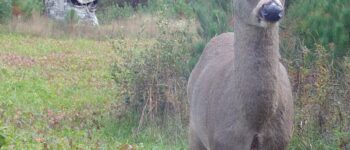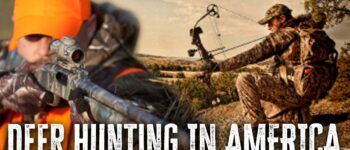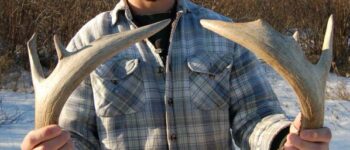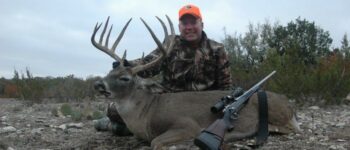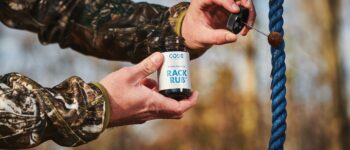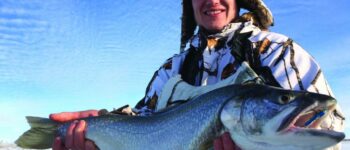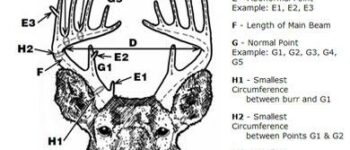Why do deer snort? Because they’re alarmed or frightened … right? Mostly, yes, that is 100 percent spot-on. However, there are other reasons why deer snort, including some you might not have thought about before today.
The above video is a neat moment I captured on my cellphone here at home on Sunday. I was turkey hunting with my daughter when we saw a string of whitetails filtering through the woods. The appeared, one by one, in the field we were watching. When they saw our turkey decoys, they immediately headed over for closer inspection.
The big, adult doe to the left was locked on our blind almost the entire time. The damp day only aided in this doe smelling our presence almost immediately. As you can see from the video, she starts high stepping, then stamping (or “stomping”) her front hoofs. That’s classic alert behavior among whitetails. After confirming an odor that she instinctively knew was danger, the doe begins blowing. If you listening closely, you can hear my daughter asking, “why is the deer snorting?”
I shushed her, because I wanted to capture this sound more clearly on the audio. Little did I realize at that very moment was Emily had never seen a deer while it was snorting.
The whitetail’s snort is an alarm signal. They make this distinctive sound (you might even say it’s a deer call) by expelling air forcefully through their nasal passages. The “whoosh” sound is created when the expelled air flutters the closed nostrils.
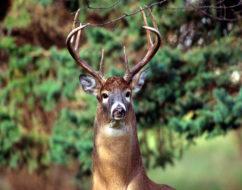
What does a deer snort sound like? Well, the snort heard in this video is the common one most hunters hear while hunting. Another type of snort is higher-pitched and almost sounds like a sharp whistle. This type of snort is more associated with eminent danger among the deer herd. When deer hear the whistle-snort, they usually almost immediately sprint for security cover without bothering to pause and look at the source of the perceived danger.
Deer Snorts Don’t Always Signal Danger
Although the snort is associated as an alarm sound, it has also been documented as a curiosity communication. I witnessed this first-hand and many times during a week-long hunt on Quebec’s Anticosti Island in 1995. The deer on that island are so unpressured that they very rarely see humans. What’s more, there are no other natural predators on Anticosti. While walking the swamp trails during my stay there, I jumped numerous deer that snorted nonstop from the time I jumped them until the time I walked past them. That’s right – I walked past them (usually getting no closer than 50 to 75 yards). Many of these deer did not flee more than a few yards. Invariably, they trotted a few yards away, stopped, looked at me, and then went back to feeding. They were surprised but not scared to the point of high-tailing it away.
Body Language of a Snorting Deer
The tail flick, hoof stomp and tail flair are three body language signs deer use in conjunction with a snort. These are instinctual visual clues that alert other deer to the perceived threat. We don’t know this with 100 percent certainty, but it is believed that a snort is a valid indication that the deer has smelled danger. Hoof stomping and tail signals are typically associated with visual confirmation of perceived danger.
Fight or Flight Response
The more I learn about deer physiology, the more I’m fascinated by how physical behavior are often linked to chemical makeup. In the case of the whitetail, it is quite possible the snort behavior is linked to the animal’s chemical reaction to danger. Specifically, the flight response to danger is heightened by the increased flow of adrenaline (epinephrin). This compound floods the deer’s circulatory system during heightened times of danger.
With adrenaline (hormones) flooding the bloodstream, the deer is primed to sprint from danger. We have learned this through scientific research, and the speculation here is that a snort (which comes with awareness and forceful action) might serve the same purpose — prepare the deer’s circulatory with the oxygen and chemicals needed to maintain a lightning-quick danger response.
— Daniel Schmidt has been with Deer & Deer Hunting since 1995, and has written the “Whitetail Wisdom” blog for more than 15 years. He lists Leonard Lee Rue III, John J. Ozoga and the late Charles J. Alsheimer as his top influencers.
JOIN THE CAMPFIRE AT THE SATURDAY NIGHT DEER CAMP!
Deer & Deer Hunting invites you to our new Saturday Night Deer Camp, only on Pursuit Channel.
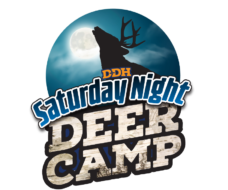 Saturday Night Deer Camp is a primetime block of shows kicked off each week with the award-winning Deer & Deer Hunting TV. Hosted by Dan Schmidt, Gordy Krahn, Mark Kayser and Steve Bartylla, the show is in its 14th season and covers everything related to deer hunting, from tactics and strategy to gear, biology, great hunts and more.
Saturday Night Deer Camp is a primetime block of shows kicked off each week with the award-winning Deer & Deer Hunting TV. Hosted by Dan Schmidt, Gordy Krahn, Mark Kayser and Steve Bartylla, the show is in its 14th season and covers everything related to deer hunting, from tactics and strategy to gear, biology, great hunts and more.
Following DDH TV, you can watch Destination Whitetail, The Given Right with Kenneth Lancaster and then Land of Whitetail. These four shows make Saturday Night Deer Camp your must-watch viewing this year.
Check your local listings for Pursuit Channel. It’s also available now on AT&T U-Verse, Channel 1644, among other networks.
